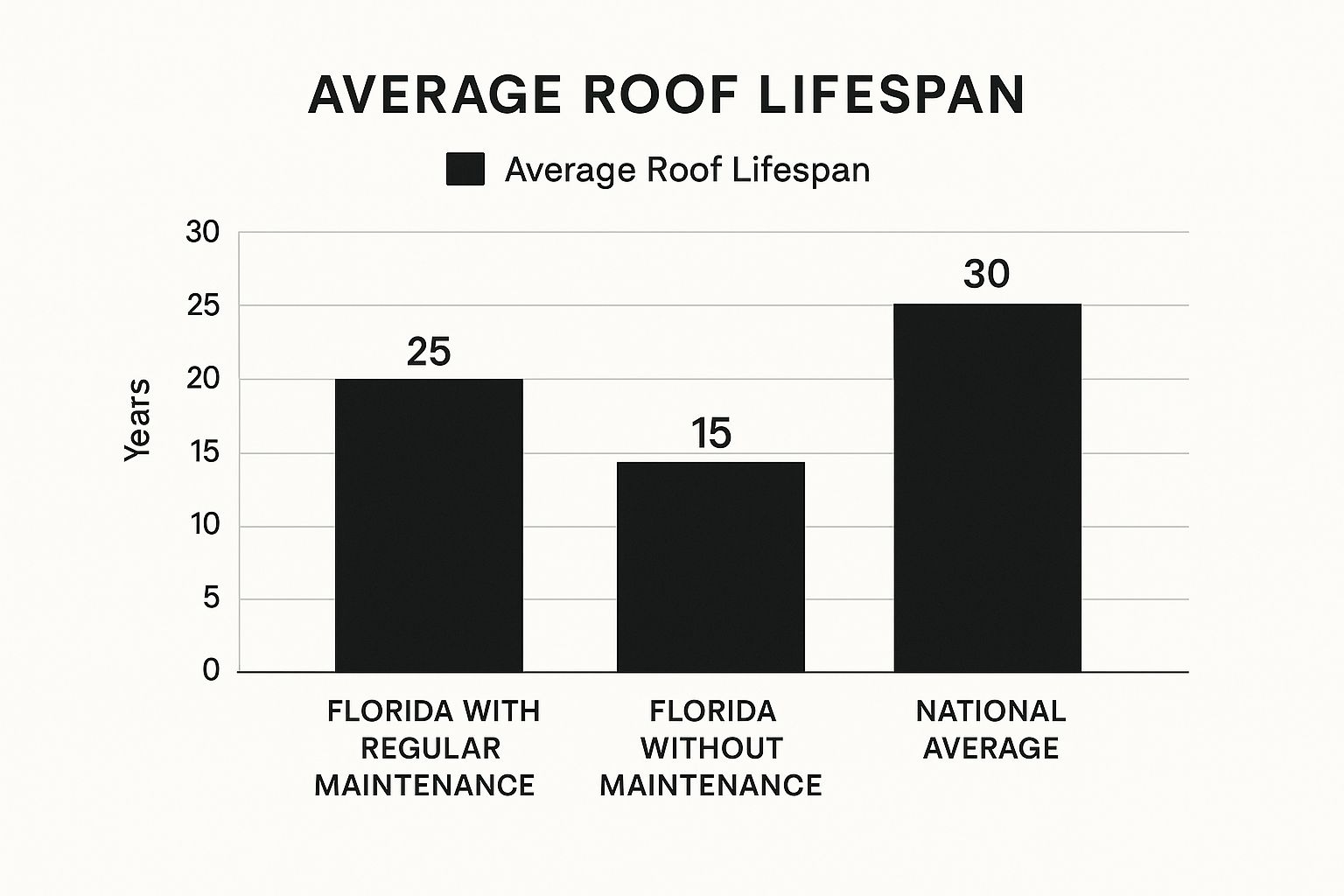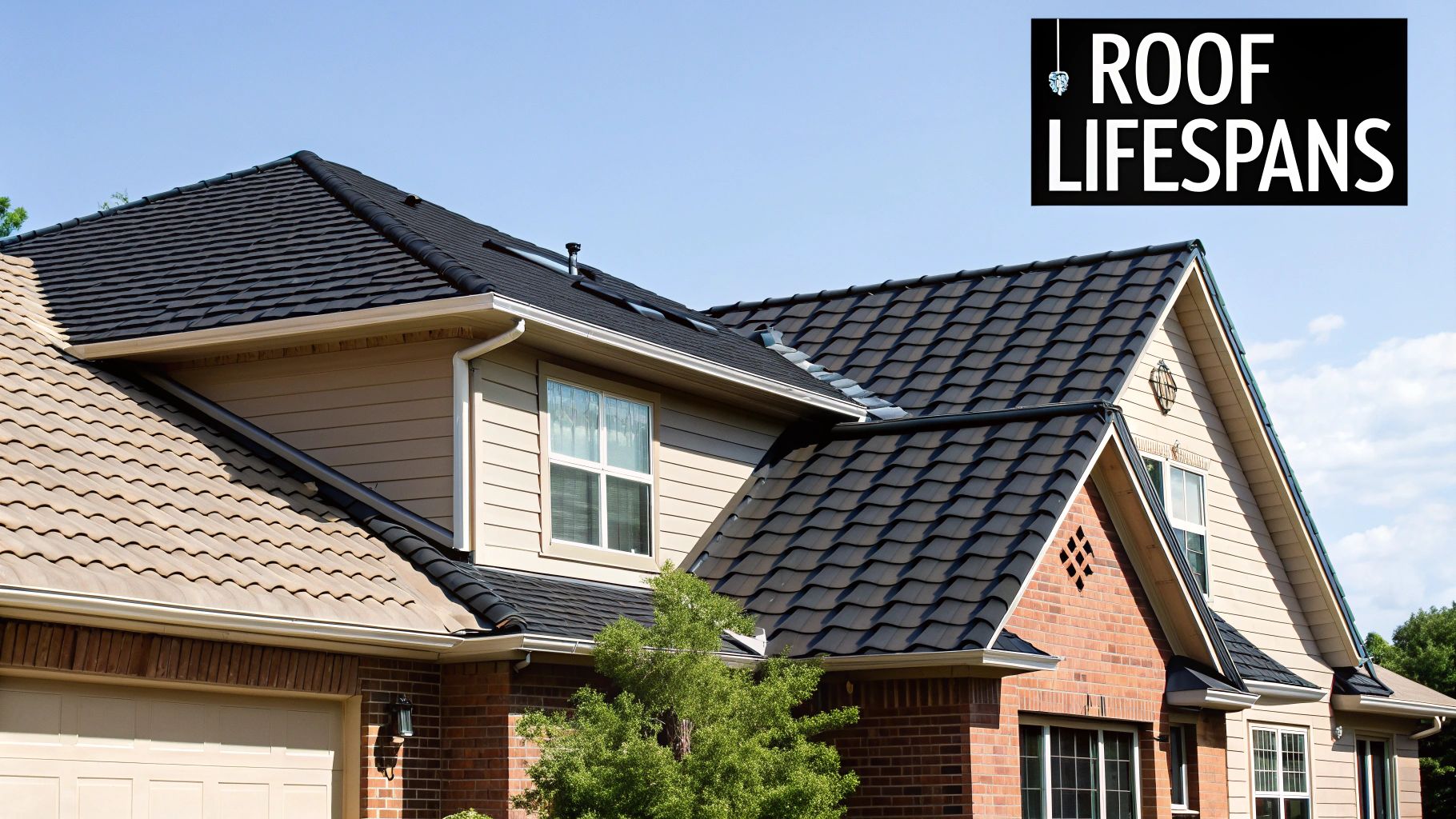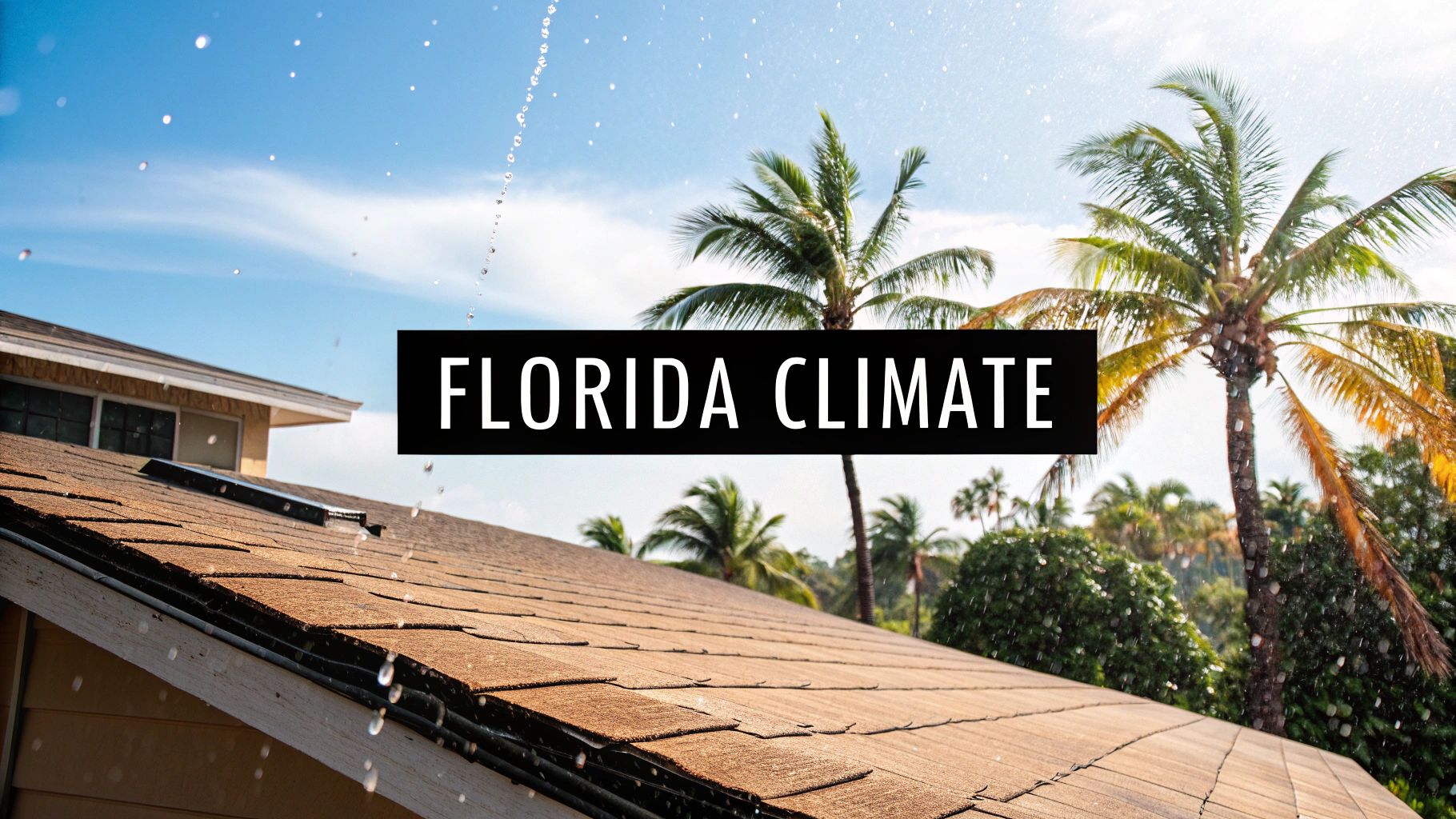In Florida, asking how long a roof lasts can get you answers ranging from 15 to 50+ years. The real, actionable answer depends on two critical factors: the material you install and the maintenance you perform.
A standard asphalt shingle roof, for example, might only provide 15-25 years of service. In contrast, you can strategically invest in premium materials like metal or tile, which are engineered to last 50 years or more, even under Florida's relentless climate assault.
Understanding Florida Roof Lifespan By Material
Think of your roof as your home’s first line of defense. It's the primary shield against blistering sun, suffocating humidity, and, of course, hurricane-force winds. A roof in a milder state has it easy compared to one in Florida, which is in a constant battle with the elements.
This relentless exposure means your choice of roofing material isn't just an aesthetic one—it's the single most important factor determining how long it will hold up. Some materials are simply better engineered to handle the heat and storms, while others break down much faster under the constant pressure.
To give you a clearer picture, we've broken down the most common roofing materials and what you can realistically expect from them in our unique climate.
Florida Roof Lifespan Comparison by Material
Use this table to make a direct, side-by-side comparison of the most popular roofing choices for Florida homes. It covers not just lifespan but also the cost and key strategic advantages of each option.
| Roofing Material | Average Lifespan in Florida | Relative Cost | Key Advantages |
|---|---|---|---|
| Asphalt Shingles | 15-25 years | Low | Most affordable option, wide variety of colors |
| Metal Roof | 40-70 years | High | Excellent durability, energy-efficient, hurricane resistant |
| Tile (Clay/Concrete) | 50-100+ years | Very High | Unmatched longevity, classic look, superior fire resistance |
| Wood Shake | 20-30 years | High | Natural, rustic aesthetic |
| Flat Roof (TPO/Modified Bitumen) | 10-20 years | Medium | Ideal for modern architecture, good for mounting HVAC |
As you can see, the difference is dramatic. While affordable, asphalt shingles have the shortest service life. For maximum durability, nothing beats a properly installed tile roof, which can easily last a lifetime.
Why Maintenance Makes a Major Difference
In Florida, proactive roof care isn't just a good idea; it's a necessity. Simple, regular maintenance can tack years onto your roof's life, while neglect can slash it in half. It’s that simple.
Just look at the impact routine care has on a roof's longevity here in the Sunshine State.

The data doesn't lie. A well-maintained roof in Florida can last up to 10 years longer than one that's ignored. That's a decade more of protection and peace of mind.
This is especially critical if you're thinking about other major home projects. You have to know your roof's condition before starting anything that interacts with it. Considering Solar Panels in Tampa, FL? A strong, healthy roof is an absolute prerequisite for a safe and successful solar installation.
Why Florida's Climate Is So Tough on Roofs

A roof rated for 30 years up north might only give you 20 years of service in Florida. This isn't due to subpar materials; it's because our weather wages a constant war on your home. To truly answer how long does a roof last in Florida, you must understand the four primary threats it faces daily: UV rays, humidity, rain, and wind.
Each of these elements systematically degrades your roof, aging it far faster than in a gentler climate. This constant assault is precisely why proactive maintenance is non-negotiable. For more on that, take a look at our guide on improving your home's health through regular upkeep and optimization.
The numbers prove it: a startling 21.6% of Florida's roofs are in critical or severe condition, compared to the national average of just 1.4%. This gap is a direct result of our climate. If you're a data nerd, you can dive into the data-driven view of Florida roof risk to see the full picture.
The Four Main Climate Attackers
Here are the four biggest culprits that team up to wear down even the toughest roofing materials:
-
Intense UV Radiation: Florida's sun bakes the vital oils out of asphalt shingles, stripping them of flexibility. This makes them brittle, prone to cracking, and causes them to shed their protective granules.
-
High Humidity and Moisture: Our humidity creates a perfect breeding ground for algae and mold. Those ugly black streaks on many roofs are an algae called Gloeocapsa magma, and it actively eats the limestone filler in your shingles, causing decay.
The combination of heat and moisture is a devastating one-two punch. The heat weakens the material's defenses, and the constant dampness seeps into those weak spots, leading to rot, algae, and water intrusion that threatens your entire home.
-
Frequent Torrential Rain: We don't just get gentle showers; we get intense, wind-driven downpours. This rain batters your roof, forcing water under shingles and into every seam. Over time, this pressure test creates leaks where none existed before.
-
Hurricane-Force Winds: This is the most direct threat. It’s not just about shingles being torn off. Extreme winds create a powerful pressure difference that can lift the entire roof deck from the frame. This "uplift" severely weakens the roof's structure, making it vulnerable to the next storm.
Choosing the Right Roofing Material for Florida

Now that you understand the forces at play, it's time to choose your armor. The right material selection directly impacts your roof's longevity, your energy bills, and your peace of mind during storm season.
Think of it like buying tires. You wouldn't put highway tires on a truck you plan to take off-roading. Similarly, a roofing material that works in a mild climate might fail when faced with Florida’s brutal combination of sun, rain, and wind.
The Workhorse: Asphalt Shingles
Asphalt shingles are the most common roof you'll see, primarily because they are the most affordable option upfront. For many homeowners on a tight budget, they are the go-to choice.
However, in Florida, this low initial cost comes with a significant trade-off: a much shorter lifespan. The relentless sun bakes the essential oils out of the shingles, leaving them brittle and prone to cracking. Additionally, our humidity is a perfect breeding ground for Gloeocapsa magma—the black algae that causes ugly streaks and slowly eats away at the shingle itself.
- Florida Lifespan: Expect 15 to 20 years at best, significantly less than in northern states.
- Weakness: Prone to granule loss from sun exposure and can be easily peeled off by high winds.
- Value Proposition: The lowest installation cost, but budget for more frequent replacements.
The Resilient Choice: Metal Roofing
Metal roofing has surged in popularity across Florida for good reason. It combines incredible durability with energy efficiency that is perfectly suited for our climate.
A key advantage is heat resistance. Many modern metal roofs have "cool-roof" coatings that reflect solar radiation, keeping your attic cooler and reducing the load on your AC. In a storm, a properly installed metal roof acts as a fortress against high winds, offering far superior protection to shingles.
Actionable Insight: A professionally installed standing-seam metal roof can cut your home's cooling costs by 10-25%. Those long-term savings really help offset the higher upfront cost, making it a savvy investment over the life of the roof.
The Enduring Classic: Tile Roofing
For the ultimate in longevity and a classic Florida aesthetic, nothing surpasses tile. Made from concrete or clay, a tile roof is exceptionally heavy and tough, making it a champion against both wind and fire.
Tile is virtually immune to the rot and decay that plague other materials. While debris in a major hurricane might crack a single tile, the overall system is incredibly resilient. The mass of the tiles also provides excellent insulation, helping to stabilize your home's internal temperature.
Because of its toughness, a well-maintained tile roof will easily last 50 years or more. You can get more details on how different roofing materials stack up in Florida by reviewing this analysis.
Making the right choice comes down to balancing your budget, aesthetics, and long-term goals. While asphalt shingles save you money today, both metal and tile deliver far greater resilience and a better return on investment.
Actionable Steps to Extend Your Roof's Lifespan
Knowing the average lifespan is one thing; actively extending it is what saves you money. Protecting your home and delaying a costly replacement comes down to proactive care. This is your maintenance playbook.
Think of it like your car. You wouldn't ignore oil changes and then act surprised when the engine seizes. Your roof is the same. Consistent, simple maintenance stops tiny issues from turning into catastrophic failures.
Your Biannual Roof Inspection Checklist
Twice a year—once before hurricane season and once after—grab binoculars and perform this quick inspection from the ground. You are not a roofer, so stay safe. You are simply looking for red flags that indicate it's time to call a professional.
- Look for Visible Damage: Scan for missing, cracked, or curling shingles. On a tile roof, look for any that have slipped or are broken.
- Check Your Gutters: Look for heavy buildup of shingle granules. A few specks are normal, but a pile means the protective layer of your shingles is washing away.
- Inspect Flashing and Seals: Check the areas around vents, chimneys, and skylights. Are the seals cracked or peeling? These are the most common leak spots.
This 15-minute check can alert you to problems before they cause water damage. For a deeper dive, this comprehensive guide to roof leak prevention offers fantastic advice on spotting hidden trouble spots.
The Power of Professional Maintenance
Your ground-level check is a crucial first step, but it cannot replace a professional's trained eye. A biannual professional inspection is one of the smartest, most cost-effective investments a Florida homeowner can make.
A professional roofer sees things we don't. They can spot the subtle signs of wear and tear that are totally invisible from the ground, like hidden wind uplift damage or early material fatigue. Catching these things early can genuinely add years to your roof's life.
Pros have the safety gear and expertise to handle critical tasks you shouldn't attempt. This includes clearing stubborn debris, re-sealing vulnerable flashing, and replacing individual damaged shingles or tiles to maintain the system's integrity. A detailed  often starts with these expert check-ups.
often starts with these expert check-ups.
Simple Habits That Make a Big Difference
Incorporate these easy habits to improve your roof's health and longevity.
- Keep Gutters Clean: Clogged gutters force rainwater to back up under the roof's edge, rotting the underlying wood sheathing. This is one of the most common—and preventable—causes of serious roof damage.
- Trim Overhanging Trees: Keep limbs at least six feet from your roofline. This prevents branches from scraping shingles, dropping debris, and giving pests an easy bridge to your home.
- Address Algae Growth Promptly: See those ugly black streaks? That’s Gloeocapsa magma, an algae that eats the limestone filler in shingles. A professional soft wash with a low-pressure solution removes it without damaging your roof.
By combining your own inspections with professional expertise and these habits, you can take control of your roof's future and maximize its service life in Florida's tough climate.
Warning Signs That Your Florida Roof Is Failing

Knowing your roof's potential lifespan is helpful, but recognizing signs of failure is critical. A failing roof sends distress signals long before water stains your ceiling. Catching these red flags early can mean the difference between a simple repair and a full replacement.
Many warnings are visible from your driveway. Widespread curling or cracked shingles are a clear sign that years of sun have made the asphalt brittle and ineffective.
Another major red flag is excessive granule loss. If you see a buildup of black, sandy grit in your gutters, those are the protective granules from your shingles. Once they're gone, the raw asphalt is exposed to UV rays, and the roof's decline accelerates dramatically.
Spotting Subtle and Serious Damage
Some of the most serious issues are less obvious from the ground and require a closer look. These signs often point to major problems needing immediate attention. Protecting your family starts with a solid roof over your head. Learn more about the importance of a safe and secure family roof and what it means for your peace of mind.
Here's an actionable test: on a bright day, go into your attic and turn off the lights. Do you see any slivers of daylight through the roof deck? If so, you've found a direct path for rain to enter your home.
Repair or Replace Checklist
Use this checklist to determine whether a problem likely requires a quick fix or a full replacement before you call a professional.
| Symptom | Likely Action Required | Urgency Level |
|---|---|---|
| A few missing or cracked shingles in one spot | Repair | Medium |
| A small, contained leak around a chimney or vent | Repair | High |
| Widespread curling, buckling, or bare spots | Replacement | High |
| Dark streaks and algae covering large areas | Replacement | Medium |
| Granules collecting in gutters and on the ground | Replacement | High |
| Visible sagging or drooping of the roofline | Replacement | Immediate |
| Multiple active leaks in different rooms | Replacement | Immediate |
While this table is a helpful guide, a professional inspection is the only way to get a definitive answer. A small symptom on the surface could be masking a much larger structural issue underneath.
Understanding Florida's Critical 25% Rule
Every Florida homeowner must understand a crucial part of the building code. It isn't just a contractor guideline; it's a state-mandated rule that can turn a major repair into a required full replacement.
The Florida Building Code's "25% Rule" states that if more than 25% of your roof is repaired or replaced within any 12-month period, the entire roofing system must be brought up to the current, modern building code.
This rule is a game-changer. If a hurricane damages a large section of your 15-year-old roof, even if the rest seems okay, the 25% Rule could force a full replacement to meet today's stricter standards. Knowing this rule is essential for budgeting and planning any significant roof work in Florida.
Answering Your Top Florida Roofing Questions
Let's tackle the most common questions we hear from Florida homeowners. Getting straight answers will give you the confidence to make the right call for your home and your budget.
How Do Hurricanes Directly Impact My Roof's Lifespan?
Hurricanes don't just shorten a roof's life; they can end it instantly. Beyond obvious damage like torn-off shingles, the invisible threat of "uplift" pressure is worse. Extreme winds try to rip the entire roof deck off the frame.
Even if your roof looks fine after a storm, that force can weaken the whole structure. Each hurricane adds cumulative stress, making the roof weaker for the next one. This is why a roof in a hurricane zone might only last 15-20 years, while the same roof in a calmer state could last 30.
Are Certain Roof Types Required for Homeowners Insurance?
Insurers don't typically mandate a specific roof type, but they are intensely focused on its age and condition. Due to recent Florida law changes, many insurers now refuse to write new policies for homes with asphalt shingle roofs over 15 years old. For tile roofs, that cut-off is often 40 years.
Getting a policy on a home with an older roof is the main hurdle. Understanding your coverage is non-negotiable, and this essential guide to homeowners insurance is a great resource.
Key Takeaway: An aging roof isn't just a leak risk—it can make your home uninsurable, creating a massive financial problem. Proactive replacement is often a financial necessity in Florida, not a luxury.
What Is a Realistic Budget for a New Florida Roof?
Roof replacement costs in Florida vary widely based on material, home size, and job complexity.
Here are some ballpark figures to help you plan:
- Asphalt Shingles: $10,000 – $18,000
- Metal Roofing: $18,000 – $35,000+
- Tile Roofing: $25,000 – $50,000+
These are starting points. The final price can change based on a full tear-off of the old roof or replacing rotted wood decking—a common issue in our climate. Always get multiple quotes from licensed, local contractors.
How Does the Florida Building Code's 25% Rule Work?
The "25% Rule" is a critical part of the Florida Building Code. Its impact is simple but huge: if more than 25% of your roof is damaged and needs repair within one year, you cannot just patch it. You are required by law to replace the entire roof to meet the latest, stronger building codes.
This means a seemingly straightforward patch job after a storm can become a mandatory and expensive full roof replacement. The rule is designed to make homes safer, but it can be a major financial shock if you aren't prepared for it.
When it comes to protecting your home from the unique challenges of the Florida climate, having an expert you can trust is essential. At Exact Roofing, we specialize in roof replacements and repairs that are built to last. If you have questions about your roof's condition or are considering a replacement, contact us today for a professional consultation.
Article created using Outrank

